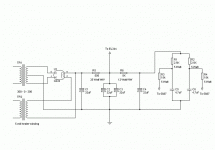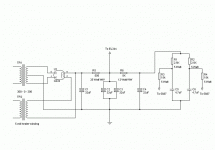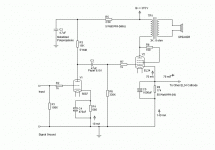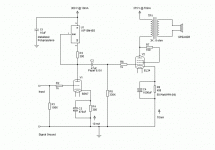Hi Frank,
I will most definately consider the choke. I have a couple of 10 H chokes on the shelf that are collecting dust. I don't know about leaving out the decoupling caps though. I could probably get away with it on the input stage but I would have no bass without the cap on the power stage. I'm not a bass monger mind you but I do like a fulll audio spectrum.
I will most definately consider the choke. I have a couple of 10 H chokes on the shelf that are collecting dust. I don't know about leaving out the decoupling caps though. I could probably get away with it on the input stage but I would have no bass without the cap on the power stage. I'm not a bass monger mind you but I do like a fulll audio spectrum.
Hi,
It won't affect banwidth at all...what omitting those caps does is provide some degenerative feedback locally.
This in turn will make for a faster sounding amp but I'll leave you to experiment with it...it's a matter of finding the right balance between slew rate and musicality.
Nonetheless, those caps are going to add their sonic signature to the picture no matter what you do IMHO.
Same goes for the PSU, the same balance between speed and musicality needs to be found with the PSU.
Interesting world, isn't it?
Cheers,
I could probably get away with it on the input stage but I would have no bass without the cap on the power stage. I'm not a bass monger mind you but I do like a fulll audio spectrum.
It won't affect banwidth at all...what omitting those caps does is provide some degenerative feedback locally.
This in turn will make for a faster sounding amp but I'll leave you to experiment with it...it's a matter of finding the right balance between slew rate and musicality.
Nonetheless, those caps are going to add their sonic signature to the picture no matter what you do IMHO.
Same goes for the PSU, the same balance between speed and musicality needs to be found with the PSU.
Interesting world, isn't it?
Cheers,
Hello Gavin;
Looking good to me for whatever that's worth!
One very small question/suggestion: what are you going to use for your plate load resistors on the 5687's? I'd suggest that you use at minimum Mills noninductives for that role. In my admittedly limited experience here I've found that resistor seems to be a big one for voicing the amp as a whole.
Good luck on it and be sure to let us all know how it turned out!!
All the best,
Morse
Looking good to me for whatever that's worth!
One very small question/suggestion: what are you going to use for your plate load resistors on the 5687's? I'd suggest that you use at minimum Mills noninductives for that role. In my admittedly limited experience here I've found that resistor seems to be a big one for voicing the amp as a whole.
Good luck on it and be sure to let us all know how it turned out!!
All the best,
Morse
Hello Gavin;
Actually, I'm a carbon composition kind of guy for plate load resistors (unless the amp comes out too warm, then I go with metal films there as my first try at chilling it down), but you're going to have trouble finding anything bigger than 2w in a CC these days. If Kiwame makes a CF that's got the goods to handle the 2.16 watts of power through the plate loads, go for it. I just was a little afraid from your lack of specifics in your schematic that you were going to use a generic metal oxide power resistor!
FWIW the MIlls are my resistor of choice for crossover work, and you'd specified them elsewhere, which is why I commented that I'd go with those 'at minimum' for plate loads.
My bad for not spelling out my thoughts better!
Anyway, good luck and all the best,
Morse
Actually, I'm a carbon composition kind of guy for plate load resistors (unless the amp comes out too warm, then I go with metal films there as my first try at chilling it down), but you're going to have trouble finding anything bigger than 2w in a CC these days. If Kiwame makes a CF that's got the goods to handle the 2.16 watts of power through the plate loads, go for it. I just was a little afraid from your lack of specifics in your schematic that you were going to use a generic metal oxide power resistor!
FWIW the MIlls are my resistor of choice for crossover work, and you'd specified them elsewhere, which is why I commented that I'd go with those 'at minimum' for plate loads.
My bad for not spelling out my thoughts better!
Anyway, good luck and all the best,
Morse
Hi Morse,
I use Kiwame carbon films (5 watt) in that position. They are available from Michael Percy. I've heard a lot of people complain about him but I've never had any problems. I just send a list and he sends me a total and I pay through PayPal. The Kiwame's are on the last page of his PDF catalog that can be found here:
http://www.percyaudio.com/Catalog.pdf
Have a good one.
I use Kiwame carbon films (5 watt) in that position. They are available from Michael Percy. I've heard a lot of people complain about him but I've never had any problems. I just send a list and he sends me a total and I pay through PayPal. The Kiwame's are on the last page of his PDF catalog that can be found here:
http://www.percyaudio.com/Catalog.pdf
Have a good one.
G said:Actually I was planning on using Kiwame carbon films. Have you had good luck using Mills in that position? What was the difference in sound?
The Mills are my preference, but I've also used lots of Kiwames and they'll be fine.
My experience with the Kiwames has been in modding vintage gear or as the cathode R's in my amps, as I usually need more power dissipation in the anode loads. So no comment on sonics in that app. The Kiwames have much better than the 5% tolerance they're usually advertised with.
- just saw your post above:
I like to use the 1/4 ratio for resistors, ie whatever their power dissipation will actually be in circuit, should be about 1/4 of their rating.
I've also never had any problems with Michael Percy. I just don't think he has any time for the people who want their hands held. If you supply a list of parts reqd, get a total and pay, I've always had the order out the door the same day.
Hello Gavin;
I've ordered a few things through Michael Percy over the years and I echo your sentiments - I've never had any troubles with him!
Hmmm, I can tell that I should look through his catalogue again, since I'd forgotten that Kiwame made a CF with that high a dissipation rating! Of course these days I'm going strictly economy class, so that's one reason I haven't been looking at his catalague much!
All the best,
Morse
I've ordered a few things through Michael Percy over the years and I echo your sentiments - I've never had any troubles with him!
Hmmm, I can tell that I should look through his catalogue again, since I'd forgotten that Kiwame made a CF with that high a dissipation rating! Of course these days I'm going strictly economy class, so that's one reason I haven't been looking at his catalague much!
All the best,
Morse
I've only ever seen the Rikens listed as 0.5,1 and 2W. At $US3.60 ea for the 2W, I think I'd rather spend $US2.65 on MRB5 Mills (PCX prices)analog_sa said:The Kiwames are ok but the Rikens are really better, while offering similar sound. Not sure if you can get them in 5W though.
Hi Brett,
Like you I'm into overkill myself. I like a lot of breathing room on the power rating of my resistors and capacitors. Once I build something I want it to work for a long time. I've heard that wirewounds (noninductive of course) are great for cathodes but this is the first I've heard mentioned of using them on the plates. Hell, I can use them in every position if they sound good.
Like you I'm into overkill myself. I like a lot of breathing room on the power rating of my resistors and capacitors. Once I build something I want it to work for a long time. I've heard that wirewounds (noninductive of course) are great for cathodes but this is the first I've heard mentioned of using them on the plates. Hell, I can use them in every position if they sound good.
G said:Like you I'm into overkill myself. I like a lot of breathing room on the power rating of my resistors and capacitors. Once I build something I want it to work for a long time.
I like to over-rate components that get hot, and space them away from other components as much as is practical, especially caps. The 4x rule hasn't failed me yet and was something I learned after college and Uni by a few old time engineers I worked with. If it broke, you didn't know how to design something was their way of looking at it, and I generally agree.
I've heard that wirewounds (noninductive of course) are great for cathodes but this is the first I've heard mentioned of using them on the plates.
They work well as plate load. As well as good dissipation they have a higher voltage rating and a lower voltage coefficient from memory. They're also really tough; I've had some Mills run a lot over spec when I was experimenting and made some miscalculations.
If I have them on hand I use the Mills 12W for all my anode loads. Good sounding (ie I hear nothing wrong) and the price isn't too bad.
Hell, I can use them in every position if they sound good.
I'd suggest only the anodes, and cathodes if you need the dissipation.
For all other small signal, non-power applications, metal films or carbons or even bulk foils depending on your budget and what takes your fancy. If you haven't experimented with different types before, use generic metal films like Beyschlags (BC, Philips, Dale etc), get the circuit working really well with them in place, and then futz with it to get it to sound the way you like. Resistors are usually only a small percentage of the final sound with tube biassing being a bigger change than most resistors IME. Once the circuit itself is dialled in, then play with fancier components, but be prepared to find they either don't sound much/any different or sound worse than what you just swapped out. Also, don't get too uptight or anal about it, as some people certainly do. The circuit, output transformers and the power supply are more important, and I'd advise spending an extra $50 on better OPTs than I would on tantalum resistors.
Hi all,
After looking at the curves for a 5687 I noticed that the gain stage in the amp I posted would not be biased in a very linear way. I then casted about for an alternative driver. I decided that a Mu follower 6SN7 circuit would probably sound pretty nice. That many people can't be wrong. So I did some research and some number crunching and got exactly nowhere. So I decided that a CCS plate load on a 6SN7 would allow me to keep the rest the design intact with the exception of the gain stage. I remembered something I had seen on Peter Millet's site a while back and after enlisting a little help and advice from Peter I decided to use the 6SN7 instead of the 5687. Any thoughts? Please don't ask about the biasing of the regulator because the spec sheet is not at all clear on that. I used the value that I picked up on Peter's site. I will have to experiment with the biasing when I get it built. I've never heard any complaints about the sound of a 6SN7 so it should work out well. The article and a link the the IXYS current regulator is here:
http://pmillett.addr.com/current_source.htm
After looking at the curves for a 5687 I noticed that the gain stage in the amp I posted would not be biased in a very linear way. I then casted about for an alternative driver. I decided that a Mu follower 6SN7 circuit would probably sound pretty nice. That many people can't be wrong. So I did some research and some number crunching and got exactly nowhere. So I decided that a CCS plate load on a 6SN7 would allow me to keep the rest the design intact with the exception of the gain stage. I remembered something I had seen on Peter Millet's site a while back and after enlisting a little help and advice from Peter I decided to use the 6SN7 instead of the 5687. Any thoughts? Please don't ask about the biasing of the regulator because the spec sheet is not at all clear on that. I used the value that I picked up on Peter's site. I will have to experiment with the biasing when I get it built. I've never heard any complaints about the sound of a 6SN7 so it should work out well. The article and a link the the IXYS current regulator is here:
http://pmillett.addr.com/current_source.htm
Attachments
- Status
- This old topic is closed. If you want to reopen this topic, contact a moderator using the "Report Post" button.
- Home
- Amplifiers
- Tubes / Valves
- Recommendations on a simple design?



